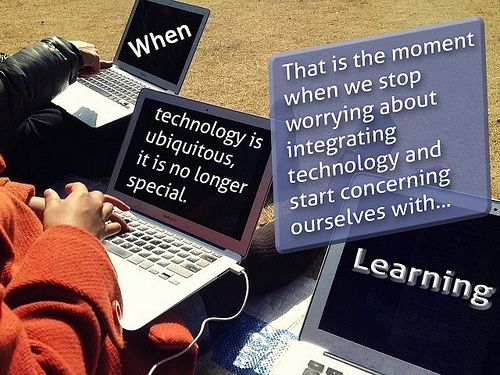
photo credit: ransomtech via photopin cc
The idea of putting learners at the centre of learning was a theme that ran through many of the presentations, including the main Blackboard corporate presentations at the Blackboard Teaching and Learning Conference in Dublin at the beginning of May. However, I noticed two different views of ‘student-centred’ learning.
The corporate view
The Blackboard ‘Roadmap’ presentation emphasised their new or improved collaborative and social features, ‘putting the learner in control of their learning’. They are making efforts to be responsive to their local markets, and are not so American-centric as they used to be. The whole ‘Blackboard experience’ is moving at a steady medium pace toward replicating people’s day-to-day online experience. The result has been some great improvements in the way Blackboard looks and works. It’s becoming more slick, less ‘clunky’ and linear. But their view of ‘learner-centred’ means having the learner in a confined space where they can be managed and monitored throughout their Higher Education. Basically, ‘learner-centred’ is a euphemism for ‘proprietary lock-in’, while creating more ‘individualised learning’ via the exploitation of learning analytics. Blackboard are not alone in having this view of ‘learner-centred’.
The educators’ view
For the educators ‘learner-centred’ was about looking at what the students do, and what technology they use, and trying to find a pedagogical fit. For example, Professor Stephen Heppell’s keynote described his work aimed at enabling and trusting the learner to take part in the design of their learning spaces, with learning as a bottom-up collaborative process. The result is more enjoyable learning and better outcomes. It’s a familiar theme from Professor Heppell’s work.
The theme of student centredness carried on in several of the workshops I attended. Most interesting for me was Brian Hipkin’s session – ‘The Culture of Always On – How not to Disengage in the Age of Engagement’. It took a refreshing view of students’ use of mobile devices, and learner-centredness. The main point made is that people want to engage, it is a natural human drive to want to connect with others, and mobile technology is a means of doing it.
Brian rejects the idea that today’s young people are ‘digital natives’, instead they are ‘unconsciously competent’ with their technology, they can use their devices to connect and to find information which threatens the traditional university model of ‘I know more than you’. Reflecting Stephen Heppell’s view that learners need a space in which they can share and collaborate, Brian suggested that what universities should do for their learners is provide fast wireless connectivity and somewhere to plug in devices and work together, instead of building rooms full of PCs at great expense.
He thinks that ‘the internet generation have graduated and the smartphone generation have arrived’. Students are ‘always on’, they are constantly checking their phones – ‘tethered’ to technology and always accessible. If we are to engage them we need to understand and capitalise on their ways of using mobile devices by pushing timely information to them, such as:
- timetabling in the first few weeks,
- exam rooms during exam times,
- information for new students at the the start of term,
- providing links to content via text, or putting QR codes on posters,
- deadline reminders.
Send texts with information, don’t force them to use a university email account. Also, it is not enough to just have a Twitter and Facebook presence, these need to be constantly updated and you need to engage with people – students who follow a Facebook or Twitter feed will be checking it regularly, if it’s not updated they stop following.
An important point is that the device is not a learning device in itself, it is a means of connecting to other people and to learning content, and ‘mobile learning’ is a means of engagement and of presenting content.
A learning technologist’s view
Twitter is the the jumping off point for a lot of discussion about learning technology. Because of this learning technologists use soundbites and buzz words to summarise complex issues, which is fine as a starting point to a discussion. The problem is that those complex issues often become reduced to facile truisms. Two examples in relation to educational technology are: ‘we need to follow the students’, and ‘it’s not about the technology, it’s about the learning’. These annoy me because, first, ‘following the students’ often ends up with a techno-centric view of their learning – the talk is about about the devices they use, rather than what they do with them. And second, although I understand the sentiment behind the phrase, in a sense it *is* about the technology because technology and learning aren’t separate entities – the ‘what’, and the ‘how’. There’s just the ‘how’ because technology is one part of a process, not a just a thing that you take off the shelf and plug in. It’s a part of how we do stuff, including learning – ‘the culture of always on’. Brian’s session highlighted this point very well. What he demonstrated is that mobile learning is about a way of designing and delivering content and information, and about providing ways to communicate and collaborate. Disengagement occurs when we don’t begin to address the way in which students actually use mobile devices (or any digital technology) in education – this is what ‘following the students’ and ‘it’s not about the technology…’ should mean.


 Subscribe to Stephen Walker's posts
Subscribe to Stephen Walker's posts
Recent Comments